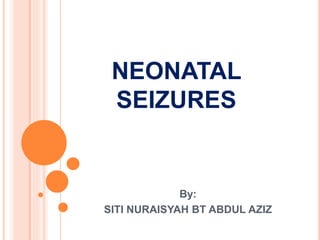
Neonatal seizures presentation
- 1. NEONATAL SEIZURES By: SITI NURAISYAH BT ABDUL AZIZ
- 2. DEFINITION As a paroxysmal alteration in neurologic function, i.e. motor, behavior and/or autonomic function. Neonatal seizures or neonatal convulsions are epileptic fits occurring from birth to the end of the neonatal period. The neonatal period is the most vulnerable of all periods of life for developing seizures, particularly in the first 1–2 days to the first week from birth.
- 3. Seizures are the most frequent manifestation of neonatal neurological diseases. It is important to recognize seizures, determine aetiology and treat them as: 1. The seizures may be related to diseases that require specific treatment. 2. The seizures may interfere with supportive measures e.g. feeding and assisted respiration for associated disorders. 3. The seizures per se may lead to brain injury.
- 4. PATHOPHSIOLOGY The early postnatal development time is a period of increased susceptibility to seizures in relation to other ages. This may be due to a combination of factors specific to the developing brain that enhance excitation and diminish inhibition. There is an unequal distribution of anticonvulsant and proconvulsant neuro-transmitters and networks.
- 6. ETIOLOGY
- 7. HIE Usually secondary to perinatal asphyxia is the commonest cause of seizure in neonates, constituting 50-65% of all seizures. Most seizures (50-65%) due to HIE start within 12 hrs, remaining have an onset within 24-48 hours. Subtle seizures are the most common type of seizures following HIE.
- 8. INTRACRANIAL HEMORRHAGE Seizures due to sub-arachnoid, intraparenchymal or subdural hemorrhage occur more often in term neonates, while seizures secondary to intraventricular hemorrhage (IVH) occur in preterm infants. Most seizures due to intracranial hemorrhage occur between 2-7 days
- 9. Intracranial Infection Common organisms are group B streptococci, E. coli., toxoplasmosis, herpes simplex, coxsackie B, rubella and cytomegalovirus. Malformations of cortical development Neuronal migration disorder resulting in cerebral cortical dysgenesis
- 10. METABOLIC DISORDERS Common metabolic causes of seizures include hypoglycemia, hypocalcemia, hypomagnesemia. Rare causes include pyridoxine deficiency and inborn errors of metabolism (IEM).
- 11. SEIZURES VERSUS JITTERINESS AND OTHER NON-EPILEPTIC MOVEMENTS
- 12. Other normal movement during sleep (Myoclonic jerks as infant wakes from sleep) or when awake/ drowsy (roving sometimes dysconjugate eye movements, sucking not accompanied by ocular fixation or deviation) in newborns may be mistaken for seizures.
- 13. DIAGNOSIS/APPROACH 1) Seizure history eye movements restraint of episode by passive flexion of the affected limb change in color of skin (mottling or cyanosis) autonomic phenomena infant was conscious/ sleeping at the time of seizure should be elicited The day of life on which the seizure occurred
- 14. 2) Antenatal history Intruterine infection, maternal diabetes and narcotic addiction 3) Perinatal history Perinatal asphyxia is the commonest cause of neonatal seizures and a detailed history including history of fetal distress, decreased fetal movements, instrumental delivery,
- 15. Need for resuscitation in the labor room, low Apgar scores (<3 at 1 and/ or 5 minutes) and abnormal cord pH (≤7) and base deficit (> 10 mEq/L) should be obtained. Use of a pudendal block for mid-cavity forceps may be associated with accidental injection of the local anesthetic into the fetal scalp
- 16. 4) Feeding history: Appearance of clinical features including lethargy, poor activity, drowsiness, and vomiting after initiation of breast-feeding may be suggestive of inborn errors of metabolism. Late onset hypocalcemia should be considered in the presence of top feeding with cows’ milk.
- 17. 5) Family history History of consanguinity in parents, family history of seizures or mental retardation and early fetal/neonatal deaths would be suggestive of inborn errors of metabolism. History of seizures in either parent or sib(s) in the neonatal period may suggest benign familial neonatal convulsions (BFNC).
- 18. GENERAL EXAMINATION CNS EXAMINATION BLOOD INVESTIGATIONS ULTRASOUND CRANIUM EEG (ELECTROENCEPHALOGRAPHY) SPECIFIC INVESTIGATIONS CT SCAN OR MRI
- 19. MANAGEMENT
- 21. DURATION OF ANTICONVULSANT THERAPY Duration of therapy depends on : 1. the probability of recurrence of seizures if the drugs are discontinued 2. the risk of subsequent epilepsy. This can be determined by considering the neonatal neurological examination, cause of the seizure and the EEG.
- 22. NEONATAL PERIOD If neonatal neurological examination becomes normal discontinue therapy If neonatal neurological examination is persistently abnormal 1. Consider etiology and obtain electroencephalogram (EEG). 2. In most cases – continue phenobarbitone, discontinue phenytoin. 3. And re-evaluate in one month.
- 23. ONE MONTH AFTER DISCHARGE If neurological examination has become normal, discontinue phenobarbitone over 2 weeks. If neurological examination is persistently abnormal, obtain EEG. 1. If no seizure activity or not overtly paroxysmal on EEG, discontinue phenobarbitone over 2 weeks. 2. If seizure activity is overtly paroxysmal continue phenobarbitone until 3 months of age and reassess in the same manner.
- 24. PROGNOSIS
- 25. Thank you
